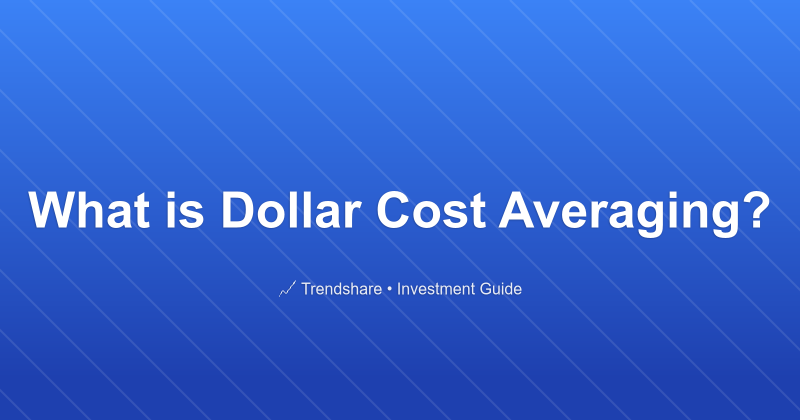
What is Dollar Cost Averaging?
By Ethan Mercer
Financial Technology Analyst • 10+ years in fintech and payments
What is dollar cost averaging in stocks? How to buy low and sell high regularly, and when cost averaging investing does and doesn't work.
If you've already invested your first $1000 in the stock market, congratulations! Your strategy now is probably to invest money at regular intervals. If you're fortunate enough to have a 401(k) account through an employer, you can deduct and invest money from every paycheck.
If that's not your situation—or if you want to invest money outside of a payroll deduction system—then you have must decide how often and how much to you invest. That decision depends on your financial situation, but it also includes an element of strategy.
What is Timing the Market?
If you follow the mantra to buy low and sell high, you soon realize that "high" and "low" are poorly defined. Maybe the Dow or S&P 500 are bumping up against record highs, or maybe they've been in the doldrums for a while. How much higher or lower will they go?
You can't predict that. Lower prices could always be around the corner. If you're always waiting for the market to bottom out, you'll never buy. The only guarantee is that if you never buy, you'll always miss good opportunities. You won't lose money if you never buy, but over time the indexes provide good returns to investors, even though days and weeks and months and even individual years may lose money.
If you're buying individual stocks, value matters, but your decision there is about whether the stock is worth its current price, not whether it can get cheaper.
What is Dollar Cost Averaging?
What if instead you always bought $1000 (or $500 or $17,000 or whatever) worth of stock on the first day of every month? Dollar cost averaging is the strategy where you buy fewer shares when the market is up (because prices are higher) and you buy more shares when the market is down (because prices are lower). You always spend the same dollar amount, but the cost you pay every month per share varies. Thus the average cost per share changes every month.
You might also hear DCA called a constant dollar plan or cost averaging investing (but not position cost averaging, which is proprietary software for automated trading—not the sort of thing value investors use).
Averaging can lessen your risk of buying at the wrong time; suppose in January you buy a stock at its yearly high. If the price has gone down in February, you'll buy more shares and push your average cost down. Similarly with March and so on.
Constant Dollar Plan Investing
If you have a budget which allows you to put $100, $500, $1000 into stocks every month, you're in prime position to take advantage of this strategy. A constant dollar plan is a strategy where you put the same amount of money into an investment at regular intervals. (Sound familiar?) This is a fantastic mechanism to keep investing over a long period of time, especially if you have a great investment you expect to keep growing, like the S&P 500 or an undervalued stock.
There are two caveats to this approach. First, you should review your investment regularly to see if it's still valuable—this is different from choosing different investments every time, but it's a regular checkin to see if your money could be better off elsewhere. Second, be aware of any broker fees or commissions you're paying. If it costs you $10 to make a $100 trade, you might batch up your monthly contribution and only invest every three months, so as to reduce the percentage of your contribution that you pay in fees.
Dollar Cost Averaging versus Lump Sum Buying
If dollar cost averaging is good, does it make sense to buy all of your stocks gradually over time? Not really! Every day you're out of the market, you miss some opportunity to earn money through price gains and dividends. It's mathematically possible to time the market such that DCA of $12,000 over a year period would gain you more than investing $12,000 on January 2, but you have have really good timing (luck!) to make it work.
That's what DCA is trying to avoid.
If you can make a lump sum buy and it makes sense to do so, do it.
What about the risk of buying at the wrong time? That's where "if it makes sense" is important to value investing. Buy things on sale. Hold for a long time. If you're worried about getting too heavily in an overvalued position, you can use DCA to ease into a position gradually (but why buy something you think may be overvalued?).
Don't let your desire to find a bargain keep you out of the market forever. Compound interest and growth work magic over the long term, if you're patient—and if you invest.
Investment Disclaimer
This article is for educational purposes only and does not constitute investment advice. Stock prices, financial metrics, and market conditions change constantly. Company examples are provided for illustration and should not be considered recommendations. Always verify current data from official sources such as company investor relations pages or SEC filings, assess your own risk tolerance and investment objectives, and consult a qualified financial advisor before making investment decisions. Past performance does not guarantee future results.